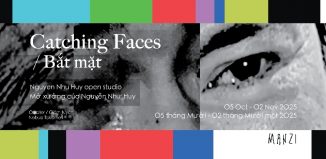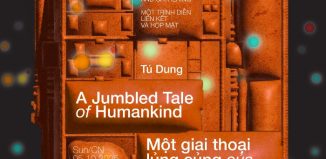KVT – Marvellous Mural Art


KVT gets re-acquainted with the work of Hitotzuki

The Japan Foundation has done it again and imported a sample of their most celebrated contemporary Pop artists for us Hanoians to enjoy.

They are Hitotzuki and are made up of Kami and Sasu. Kami has been painting murals for about fifteen years and Sasu has been painting almost as long. “We are not graffiti artists, we are mural painters,” reminds Kami. Although at one time notoriously known as graffiti writers, and prone to “getting in trouble,” the couple are married with a son and paint together as ‘Hitotzuki.’ Either operating individually or as a unit, they are two of the most successful artists to emerge from Japan’s graffiti scene.
In 2012 the foundation gave us Paramodel which I raved about on this site and followed the installation for days until it was complete. Paramodel is just about to be a star at this major international art festival in Australia.
And it was in Australia that I first came across The Japan Foundation’s latest international star visitors who, like Paramodel, have been able to use the exterior of the Foundations headquarters on the corner of Quang Trung and Tran Hung Dao as a canvas. They commenced painting on December 6 and finished 8 days later. The results are on show until early February. The new mural work is called ‘Abilight’… meaning ability and light.




In Melbourne in 2010 Kami and Sasu, and their then one year old son, were the toast of the town…especially amongst young art lovers who were intrigued by the pairs move from hit and run graffiti taggers to accepted members of the art establishment. Some images of that Omni exhibition here plus a You Tube link that shows them working
Backwoods Gallery is proud to be hosting this landmark international event.



[youtube]http://www.youtube.com/watch?v=LG53w5C-3_Y[/youtube]
Like Paramodel the duo like to use black, blue and white as their main color scheme with occasional lapses into other shades


They explain that their preference for the three colors is due to their infatuation with them and though their may be some spiritual or cosmic intent many viewers and reviewers grappling with Hitotzuki works like to embellish them with Zen, and Cosmic importance.
Here’s one gallery statement about the pair and their work: An artistic collaboration formed in 1999 by KAMI and SASU, aimed at expanding the stage for creativity rooted in the dimension of street culture. Their distinctive worldview stems from the fluid interaction between the dynamically flowing curves fashioned by KAMI, and the strong and flamboyant symmetric motifs engineered by SASU. This vision breaths new life into the sense of beauty derived from the street, and has succeeded in invigorating the era with a steady stream of vivid new landscapes. The pair views art as lying in the domains of their everyday lives, and while based in Tokyo, continues to lead a lifestyle interspersed with creative journeys around Japan and to overseas destinations.
“HITOTZUKI”, stands for the sun and the moon, being contrary to one another,
they differ yet fuse together. Through their ideology, depicting scenery from their lifestyle and feelings.
I’m not a big fan of most unsolicited street graffiti art and I wish the taggers and wannabe artists wouldn’t despoil urban landscapes that are beautiful in themselves. Last year, in Lisbon, I was ready to cry with grief and rage at the crappy stuff put up over old laneways in the wee dark hours by crappy people with spray cans.
But if you look at examples in the following link you can appreciate how some hit and runners may be invited to bridge the gap and become graffiti artists solicited to put up permanent murals. And if you click here you see a bit of solicited Hitozuki street stuff interspersed with a lot of other excellent pieces and a few of the afore mentioned crappy tags.
I’d have loved to have experienced the skate park installation Hitotsuki had at the Mori Art Museum in Tokyo in 2010 as part of the Firmament exhibition and consisted of a 6 meter mural and skateboard ramp upon which Kami skated. Below is an excellent You Tube link of the artist at work
Firmament/HITOZUKI


[youtube]http://www.youtube.com/watch?v=FycWqOmwF5o[/youtube]
Another of their famous works is THE WALL which was beautifully documented here
[youtube]http://www.youtube.com/watch?v=jYoBPj-Optw[/youtube]
and by Knee High Media (a bit of their edited text follows)
Kami had been searching for a wall like this for a while. The knit-cap donning artist began mixing paint. Soon thereafter thick black paint, watered down and mixed with “something special,” began to smoothly pour into one of the plastic trays. Kami took a roller and began to apply the black paint straight onto the wall. Normally graffiti writers and muralists coat their walls in a background color before they start painting but Kami was delighted enough with the wall itself that he skipped a background layer and started painting his characteristic curved, black lines directly over the moss, dirt and preexisting graffiti.
Watching Kami paint is rarely as interesting as watching him preparing to paint. To intuit the ideal size and motion of each line he stands back, tilts his head to one side and paints in the air to conjure up the right gestures for each subsequent line of his roller.
The second day is spent much the same, but solid shapes start to take form. Sasu has also started to paint her part of the wall. She paints with a similar process, but the results are much different. On the same concrete wall, underneath a then bare cherry blossom tree, Sasu starts to apply layers of paint that begin to echo in color and what begins to render is the kind of signature minimal and floral mandalas she is known for.
By the third day, Kami’s forms are almost finished and the black lines have traveled far beyond the concrete wall, now working their way over and up onto the house itself. What Kami paints is all about movement and it’s anyone’s guess as to where or how it will look when it’s finished. “Pool skating and graffiti are not so different,” says Kami in reference to his love of skateboarding, “it’s all about movement and lines.” Those lines stop grandmothers on their way to the shops or cause young children to grow quiet and wide eyed as they take in the huge, sprawling shapes over the wall. Their young son
A slow attention to detail is very important for both the couple’s work, a sense of craft- or ‘hin,’ which is a kind of positive refinement, not one of elitism but just something done carefully. Working carefully towards refinement not only is at odds with the typically rushed style of mural painting or even the frenetic pace of graffiti
As the sun sets behind some apartment blocks on the final day of painting, Kami holds his son and together with Sasu they survey the new wall. The lines look as though they could have been painted ten or twenty years ago, they seem like a natural extension of the house, and Sasu’s resonating mandala’s are colored and toned to match the flowers of the soon-to-blossom plum tree perfectly.
To make their art into an affordable lifestyle the pair have diversified into design and manufacture of goods that are distinctively them. Examples are on display at The Japan Foundation and at this link
As you can see I’m a big Hitotzuki fan and would love to be able to afford to have them muralize the walls of the new house we are considering near a beach ..with water as blue as the blue in one of their paintings.
More images of the outside walls of the Japan Foundation follow plus another link to show just how impermanent and ephemeral street art can be, even if it is produced by the at the top of the pile





THANKS AGAIN AND AGAIN YOU WONDERFUL PEOPLE AT THE JAPAN FOUNDATION
| Kiem Van Tim is a keen observer of life in general and the Hanoi cultural scene in particular and offers some of these observations to the Grapevine. KVT insists that these observations and opinion pieces are not critical reviews. Please see our Comment Guidelines / Moderation Policy and add your thoughts in the comment field below. |













